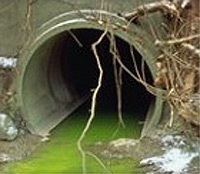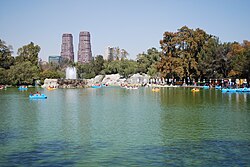Education and licensure
Civil engineers typically possess an academic degree in civil engineering. The length of study is three to five years, and the completed degree is designated as a bachelor of engineering, or a bachelor of science. The curriculum generally includes classes in physics, mathematics, project management, design and specific topics in civil engineering. After taking basic courses in most sub-disciplines of civil engineering, they move onto specialize in one or more sub-disciplines at advanced levels. While an undergraduate degree (BEng/BSc) normally provides successful students with industry-accredited qualification, some academic institutions offer post-graduate degrees (MEng/MSc), which allow students to further specialize in their particular area of interest.[16]
In most countries, a bachelor's degree in engineering represents the first step towards professional certification, and a professional body certifies the degree program. After completing a certified degree program, the engineer must satisfy a range of requirements (including work experience and exam requirements) before being certified. Once certified, the engineer is designated as a professional engineer (in the United States, Canada and South Africa), a chartered engineer (in most Commonwealth countries), a chartered professional engineer (in Australia and New Zealand), or a European engineer (in most countries of the European Union). There are international agreements between relevant professional bodies to allow engineers to practice across national borders.
The benefits of certification vary depending upon location. For example, in the United States and Canada, "only a licensed professional engineer may prepare, sign and seal, and submit engineering plans and drawings to a public authority for approval, or seal engineering work for public and private clients."[17] This requirement is enforced under provincial law such as the Engineers Act in Quebec.[18]

Sub-disciplines
In general, civil engineering is concerned with the overall interface of human created fixed projects with the greater world. General civil engineers work closely with surveyors and specialized civil engineers to design grading, drainage, pavement, water supply, sewer service,dams, electric and communications supply. General civil engineering is also referred to as site engineering, a branch of civil engineering that primarily focuses on converting a tract of land from one usage to another. Site engineers spend time visiting project sites, meeting with stakeholders, and preparing construction plans. Civil engineers apply the principles of geotechnical engineering, structural engineering, environmental engineering, transportation engineering and construction engineering to residential, commercial, industrial and public works projects of all sizes and levels of construction.
Materials science and Engineering
Main article: Materials science
Materials science is closely related to civil engineering. It studies fundamental characteristics of materials, and deals with ceramics such as concrete and mix asphalt concrete, strong metals such as aluminum and steel, and polymers including polymethylmethacrylate (PMMA) and carbon fibers.
Materials engineering involves protection and prevention (paints and finishes). Alloying combines two types of metals to produce another metal with desired properties. It incorporates elements of applied physics andchemistry. With recent media attention on nanoscience and nanotechnology, materials engineering has been at the forefront of academic research. It is also an important part of forensic engineering and failure analysis
Coastal Engineering
Coastal engineering is concerned with managing coastal areas. In some jurisdictions, the terms sea defense and coastal protection mean defense against flooding and erosion, respectively. The term coastal defense is the more traditional term, but coastal management has become more popular as the field has expanded to techniques that allow erosion to claim land.

Construction Engineering
Construction engineering involves planning and execution, transportation of materials, site development based on hydraulic, environmental, structural and geotechnical engineering. As construction firms tend to have higher business risk than other types of civil engineering firms do, construction engineers often engage in more business-like transactions, for example, drafting and reviewing contracts, evaluating logistical operations, and monitoring prices of supplies.
Earthquake Engineering
Earthquake engineering involves designing structures to withstand hazardous earthquake exposures. Earthquake engineering is a sub-discipline of structural engineering. The main objectives of earthquake engineering are[21] to understand interaction of structures on the shaky ground; foresee the consequences of possible earthquakes; and design, construct and maintain structures to perform at earthquake in compliance with building codes.
Environmental Engineering
Environmental engineering is the contemporary term for sanitary engineering, though sanitary engineering traditionally had not included much of the hazardous waste management and environmental remediation work covered by environmental engineering. Public health engineering and environmental health engineering are other terms being used.
Environmental engineering deals with treatment of chemical, biological, or thermal wastes, purification of water and air, and remediation of contaminated sites after waste disposal or accidental contamination. Among the topics covered by environmental engineering are pollutant transport, water purification, waste water treatment, air pollution,solid waste treatment, and hazardous waste management. Environmental engineers administer pollution reduction, green engineering, and industrial ecology. Environmental engineers also compile information on environmental consequences of proposed actions.

Geotechnical Engineering
Geotechnical engineering studies rock and soil supporting civil engineering systems. Knowledge from the field of soil science, materials science, mechanics, and hydraulics is applied to safely and economically design foundations,retaining walls, and other structures. Environmental efforts to protectgroundwater and safely maintain landfills have spawned a new area of research called geoenvironmental engineering.[22][23]
Identification of soil properties presents challenges to geotechnical engineers.Boundary conditions are often well defined in other branches of civil engineering, but unlike steel or concrete, the material properties and behavior of soil are difficult to predict due to its variability and limitation on investigation. Furthermore, soil exhibits nonlinear (stress-dependent) strength, stiffness, and dilatancy (volume change associated with application of shear stress), making studying soil mechanics all the more difficult.
Water resources Engineering
Water resources engineering is concerned with the collection and management of water (as a natural resource). As a discipline it therefore combines elements of hydrology, environmental science, meteorology, conservation, and resource management. This area of civil engineering relates to the prediction and management of both the quality and the quantity of water in both underground (aquifers) and above ground (lakes, rivers, and streams) resources. Water resource engineers analyze and model very small to very large areas of the earth to predict the amount and content of water as it flows into, through, or out of a facility. Although the actual design of the facility maForensic engineering is the investigation of materials, products, structures or components that fail or do not operate or function as intended, causing personal injury or damage to property. The consequences of failure are dealt with by the law of product liability. The field also deals with retracing processes and procedures leading to accidents in operation of vehicles or machinery. The subject is applied most commonly in civil law cases, although it may be of use in criminal law cases. Generally the purpose of a Forensic engineering investigation is to locate cause or causes of failure with a view to improve performance or life of a component, or to assist a court in determining the facts of an accident. It can also involve investigation of intellectual property claims, especially paMunicipal engineering is concerned with municipal infrastructure. This involves specifying, designing, constructing, and maintaining streets,sidewalks, water supply networks, sewers, street lighting, municipal solid waste management and disposal, storage depots for various bulk materials used for maintenance and public works (salt, sand, etc.), public parks andcycling infrastructure. In the case of underground utility networks, it may also include the civil portion (conduits and access chambers) of the local distribution networks of electrical and telecommunications services. It can also include the optimizing of waste collection and bus service networks. Some of these disciplines overlap with other civil engineering specialties, however municipal engineering focuses on the coordination of these infrastructure networks and services, as they are often built simultaneously, and managed by the same municipal authority. Municipal engineers may also design the site civil works for large buildings, industrial plants or campuses (i.e. access roads, parking lots, potable water supply, treatment or pretreatment of waste water, site drControl engineering (or control systems engineering) is the branch of civil engineering discipline that appliescontrol theory to design systems with desired behaviors. The practice uses sensors to measure the output performance of the device being controlled (often a vehicle) and those measurements can be used to give feedback to the input actuators that can make corrections toward desired performance. When a device is designed to perform without the need of human inputs for correction it is called automatic control (such as cruise control for regulating a car's speed). Multidisciplinary in nature, control systems engineering activities focus on implementation of control systems mainly derived by mathematical modeling of systems ofControl engineering (or control systems engineering) is the branch of civil engineering discipline that appliescontrol theory to design systems with desired behaviors. The practice uses sensors to measure the output performance of the device being controlled (often a vehicle) and those measurements can be used to give feedback to the input actuators that can make corrections toward desired performance. When a device is designed to perform without the need of human inputs for correction it is called automatic control (such as cruise control for regulating a car's speed). Multidisciplinary in nature, control systems engineering activities focus on implementation of control systems mainly derived by mathematical modeling of systems of a diverse range. a diverse range.ainage, etc.)tents.y be left to other engineers.
Hydraulic engineering is concerned with the flow and conveyance of fluids, principally water. This area of civil engineering is intimately related to the design of pipelines, water supply network, drainage facilities (including bridges, dams, channels, culverts, levees, storm sewers), and canals. Hydraulic engineers design these facilities using the concepts of fluid pressure, fluid statics, fluid dynamics, and hydraulics, among others.

Structural Engineering
Structural engineering is concerned with the structural design and structural analysis of buildings, bridges, towers, flyovers (overpasses), tunnels, off shore structures like oil and gas fields in the sea,aerostructure and other structures. This involves identifying the loads which act upon a structure and the forces and stresses which arise within that structure due to those loads, and then designing the structure to successfully support and resist those loads. The loads can be self weight of the structures, other dead load, live loads, moving (wheel) load, wind load, earthquake load, load from temperature change etc. The structural engineer must design structures to be safe for their users and to successfully fulfill the function they are designed for (to be serviceable). Due to the nature of some loading conditions, sub-disciplines within structural engineering have emerged, includingwind engineering and earthquake engineering.[24]
Design considerations will include strength, stiffness, and stability of the structure when subjected to loads which may be static, such as furniture or self-weight, or dynamic, such as wind, seismic, crowd or vehicle loads, or transitory, such as temporary construction loads or impact. Other considerations include cost, constructability, safety, aesthetics and sustainability.

Surveying
Surveying is the process by which a surveyor measures certain dimensions that occur on or near the surface of the Earth. Surveying equipment, such as levels and theodolites, are used for accurate measurement of angular deviation, horizontal, vertical and slope distances. With computerisation, electronic distance measurement (EDM), total stations, GPS surveying and laser scanning have to a large extent supplanted traditional instruments. Data collected by survey measurement is converted into a graphical representation of the Earth's surface in the form of a map. This information is then used by civil engineers, contractors and realtors to design from, build on, and trade, respectively. Elements of a structure must be sized and positioned in relation to each other and to site boundaries and adjacent structures. Although surveying is a distinct profession with separate qualifications and licensing arrangements, civil engineers are trained in the basics of surveying and mapping, as well as geographic information systems. Surveyors also lay out the routes of railways, tramway tracks, highways, roads, pipelines and streets as well as position other infrastructure, such as harbors, before construction.

Transportation Engineering
Transportation engineering is concerned with moving people and goods efficiently, safely, and in a manner conducive to a vibrant community. This involves specifying, designing, constructing, and maintaining transportation infrastructure which includes streets, canals, highways, rail systems, airports, ports, and mass transit. It includes areas such as transportation design,transportation planning, traffic engineering, some aspects of urban engineering, queueing theory, pavement engineering, Intelligent Transportation System (ITS), and infrastructure management.

Forensic Engineering
Forensic engineering is the investigation of materials, products, structures or components that fail or do not operate or function as intended, causing personal injury or damage to property. The consequences of failure are dealt with by the law of product liability. The field also deals with retracing processes and procedures leading to accidents in operation of vehicles or machinery. The subject is applied most commonly in civil law cases, although it may be of use in criminal law cases. Generally the purpose of a Forensic engineering investigation is to locate cause or causes of failure with a view to improve performance or life of a component, or to assist a court in determining the facts of an accident. It can also involve investigation of intellectual property claims, especially patents.
Municipal or urban Engineering
Municipal engineering is concerned with municipal infrastructure. This involves specifying, designing, constructing, and maintaining streets,sidewalks, water supply networks, sewers, street lighting, municipal solid waste management and disposal, storage depots for various bulk materials used for maintenance and public works (salt, sand, etc.), public parks andcycling infrastructure. In the case of underground utility networks, it may also include the civil portion (conduits and access chambers) of the local distribution networks of electrical and telecommunications services. It can also include the optimizing of waste collection and bus service networks. Some of these disciplines overlap with other civil engineering specialties, however municipal engineering focuses on the coordination of these infrastructure networks and services, as they are often built simultaneously, and managed by the same municipal authority. Municipal engineers may also design the site civil works for large buildings, industrial plants or campuses (i.e. access roads, parking lots, potable water supply, treatment or pretreatment of waste water, site drainage, etc.)

Control Engineering
Control engineering (or control systems engineering) is the branch of civil engineering discipline that appliescontrol theory to design systems with desired behaviors. The practice uses sensors to measure the output performance of the device being controlled (often a vehicle) and those measurements can be used to give feedback to the input actuators that can make corrections toward desired performance. When a device is designed to perform without the need of human inputs for correction it is called automatic control (such as cruise control for regulating a car's speed). Multidisciplinary in nature, control systems engineering activities focus on implementation of control systems mainly derived by mathematical modeling of systems of a diverse range.
No comments:
Post a Comment